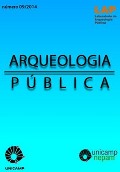Abstract
Uma pergunta costuma me atormentar, dada sua aparente obviedade: porque não podemos tocar os objetos em museus? Podemos ver, podemos olhar, mas não podemos interagir com a cultura material institucionalizada. Por quê? Embora a resposta mais óbvia seja a de que o toque pode resultar na destruição dos objetos, acredito que haja algo mais profundo envolto nessa questão, que é a construção do tato como o sentido do inculto, do selvagem. Nesse sentido, tocar ou não tocar estabelece um jogo de autoridade que define o Eu e o Outro. Ao mesmo tempo, ao se excluir a possibilidade da interação corporal com os objetos, limita-se o entendimento do público e perpetua-se um modelo específico de entender o mundo.References
AGOSTINHO. A Cidade de Deus. 7a ed. Trad. Oscar Paes Lemes. Rio de Janeiro, Editora Vozes, 2002.
ARISTÓTELES. Da Alma (De Anima). Trad. Ana Maria Lóio. Lisboa, Imprensa Nacional Casa da Moeda. 2010
BACHELARD, G. A Poética do Espaço. São Paulo: Editora Martins Fontes. 1998.
BARKAN, L. “Unearthing the Past: Archaeology and Aesthetics” In: the Making of Renaissance Culture. New Haven, Yale University Press, 1999.
BENJAMIN, W. “The Work of Art in the Age of Mechanical Reprodution”. In: Illuminations. Hannah Arendt (ed.). New York, Schocken, pp. 83-109. 1969
BENNET, T. The Birth of the Museum: History, Theory, Politics. London: Routledge. 1995.
BEZERRA, M. “As moedas dos índios: um estudo de caso sobre os significados do patrimônio arqueológico para os moradores da Vila de Joanes, ilha de Marajó, Brasil”.
Boletim do Museu Paraense Emílio Goeldi.CiênciasHumanas, vol. 6: 57-70. 2011.
BLOCH, E. Heritage of Our Time. Berkley, University of California Press. 1991
BRAUDEL, F. On History. Trad. Sarah Matthews. Chicago: University of Chicago Press. 1980.
CHATTERJEE, H. Touch in Museums: Policy and Practice in Object Handling, Oxford, Berg. 2008.
CLASSEN, C. “Museum Manners: The Sentidory Life of the Early Museum”. In: Journal of Social History, 40: 895-914. 2007
CLASSEN, C. The Deepest Sense.A Cultural History of Touch. Chicago, University of Illinois Press. 2012
CLASSEN, C; HOWES, D. “The Museum as Sensescape”: Western Sensibilities and Indigenous Artifacts. In: Edwards, E, C Gosden and R.B Philip, Sensible Objects. Colonialism, Museums and Material Culture. Oxford and New York, Berg, 199–222. 2006.
DAY, J. Making Sense of the Past. Towards a Sentidory Archaeology. Center for Archaeological Investigation Occasional Paper, n. 40. Southern Illinois University. Carbondale. 2013.
DIAS, N. La Mesure des Sens: les Anthropologues et le Corps Humainaux XIX Paris: ÉditionsFlammarion.2004
ELIAS, N. O processo civilizador: Uma história dos costumes. Rio de Janeiro: Jorge Zahar, 1994, v I.
EVERSON, S. Aristotle on Perception. New York, Oxford University Press. 2007
FIENNES, C. The Journeys of Cecilia Fiennes. Cresset, London, 1949.
FOSTER, C. “Beyond the Display Case: Creating a Multisentidory Museum Experience”. In: Day, J. 2013. Making Sense of the Past. Towards a Sentidory
Archaeology. Center for Archaeological Investigation Occasional Paper, n. 40. Southern Illinois University.Carbondale. Pp. 371-389. 2013.
GELL, A.Art and Agency: An Anthropological Theory. Oxford: Clarendon Press. 1998
HERMAN, F. The English as Collectors.London, Chatto&Windus. 1972.
HOWES, D. Empire of Senses: The Sensual Culture Reader. Berg, Oxford. 2005
HOWES, D. “Introduction: The Revolving Sentidorium”. In: HOWES, D. (Ed.). The Sixth Sense Reader. Oxford: Berg, pp. 1-542009
HOWES, D; CLASSEN, C. Doing sentidory anthropology. 2009. In: www.sentidorystudies.org/?page_id=355 acessado 07/01/2014
JONAS, H. “The Nobility of Sight: A Study in the Phenomenology of the Senses”. In: Jonas, H. The Phenomenon of Life: Toward a Philosophical Biology. New York: Harper & Row, pp.135-156. 1966.
JONES, A. “Drawn from memory: the archaeology of aesthetics and the aesthetics of archaeology in Earlier Bronze Age Britain and the present”. World Archaeology 33 (2), 334-356. 2001.
KUPPER, J. “Perception, Cognition, Volition in the Arcipreste de Talavera”. In: NICHOLS, S.; KABLITZ, A.; CALHOUN, A. (Eds.). Rethinking the Medieval Senses, Heritage, Fascinations, Frames. Baltimore: John Hopikins University Press, pp. 119-153. 2008.
MORGAN, J. Change and everyday practice at the museum: an ethnographic study. PhD thesis, University Manchester, 2011.
MOSHENSKA, J. Feeling Pleasures: The Senses of Touch in Renaissance England . A Dissertation Presented to the Faculty of Princeton University in Candidacy for the Degree of Doctor of Philosophy. Department of English. New Jersey, 2011.
PYE, E. “Introduction: the power of touch”. In: E. Pye (ed.) The Power of Touch: Handling Objects in Museum and Heritage Contexts, Walnut Creek: Left Coast Press, 13−30. 2007
SLUIJTER, E. Seductress of Sight: Studies in Dutch Art of the Golden Age. Trad.Jennifer Kilian and Katy Kist. Zwolle, Waanders, 2000.
SPIEGEL, G. “Paradoxes of the Senses”. In: NICHOLS, S.; KABLITZ, A.; CALHOUN, A. (Eds.). Rethinking the Medieval Senses, Heritage, Fascinations, Frames. Baltimore: John Hopikins University Press, pp. 186-193. 2008.
THOMAS, J. "On the ocularcentrism of archaeology". In Archaeology and the Politics of Vision in a Post-Modern Context, ed. Julian Thomas, Vitor Jorge, pp. 1-12. Cambridge, Cambridge Scholar's Press. 2009
OUZMAN, S. “Prose has its Cons. Seeing Beyond Material Culture as Text”. Paper presented to the Congress Seeing the Past: Building Knowledge of the Past and Present through Acts of Seeing. Stanford Archaeology Centre, Stanford University, USA, 5th - 6th February, 2005
REICHEL-DOLMATOFF, G. Basketry as Metaphor: Arts and Crafts of the Desana Indians of the Northwest Amazon. Los Angeles: Museum of Cultural History, University of California. 1985.
WOLF, C. “Epicuro Cartesianism: La Mettrie’sMaterialistTransformation of Early Modern Philosophy”. In: HECHT, H. (Ed.). La Mettrie. Ansichten und Einsichten. Berlin: Berlin Wissenschafts-Verlag, pp. 75-95. 2004.
A Revista Arqueologia Pública utiliza a licença do Creative Commons (CC), preservando assim, a integridade dos artigos em ambiente de acesso aberto.

